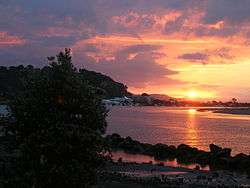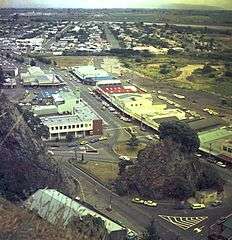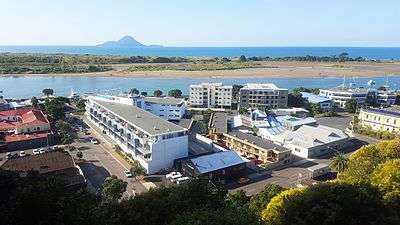Whakatane
| Whakatāne | |
|---|---|
| Town | |
 | |
| Motto: Sunshine Capital of New Zealand | |
 Whakatāne Location of Whakatāne | |
| Coordinates: NZ 37°59′S 177°00′E / 37.983°S 177.000°ECoordinates: NZ 37°59′S 177°00′E / 37.983°S 177.000°E | |
| Country |
|
| Region | Bay of Plenty |
| Territorial authority | Whakatāne District |
| Settled by Māori | c. 1200 |
| Government | |
| • Mayor | Tony Bonne |
| • Deputy Mayor | Judy Turner |
| Area | |
| • Territorial | 4,442.07 km2 (1,715.09 sq mi) |
| Population (June 2016)[1] | |
| • Territorial | 35,000 |
| • Density | 7.9/km2 (20/sq mi) |
| • Urban | 19,600 |
| Time zone | NZST (UTC+12) |
| • Summer (DST) | NZDT (UTC+13) |
| Postcode(s) | 3120 |
| Area code(s) | 07 |
| Website | http://www.whakatane.govt.nz/ |
Whakatāne (/fɑːkəˈtɑːni/ fah-kə-TAH-nee, alt. /ˌwɒkəˈtɑːni/; Māori pronunciation: [fakaˈtaːnɛ]) is a town in the eastern Bay of Plenty Region in the North Island of New Zealand, 90 km east of Tauranga and 89 km north-east of Rotorua, at the mouth of the Whakatāne River. Whakatāne District is the encompassing territorial authority, which covers an area to the south and west of the town, excluding the enclave of Kawerau.
Whakatāne has an urban population of 19,600, making it New Zealand's 24th largest urban area, and the Bay of Plenty's third largest urban area behind Tauranga and Rotorua. Another 15,400 people living in the rest of the Whakatāne District. Around 40% of the district's population have Māori ancestry. The District has a land area of 4,442.07 km2 (1,715.09 sq mi). Whakatāne District was created in 1976.
Whakatāne forms part of the parliamentary electorate of East Coast, represented by Anne Tolley of the New Zealand National Party. It is the main urban centre of the Eastern Bay Of Plenty sub-region; incorporating Whakatāne, Kawerau, and Opotiki, the Eastern Bay stretches from Otamarakau in the west, to Cape Runaway in the north-east and Whirinaki in the south. It is the seat of the Bay of Plenty Regional Council, chosen as a compromise between the region's two larger cities, Tauranga and Rotorua.
Whakatāne was affected by the 1987 Edgecumbe earthquake.
History
Maori Occupation
The site of the town has long been populated. Māori pā (Māori fortified village) sites in the area date back to the first Polynesian settlements, estimated to have been around 1200 CE. According to Māori tradition Toi-te-huatahi, later known as Toi-kai-rakau, landed at Whakatāne about 1150 CE in search of his grandson Whatonga. Failing to find Whatonga, he settled in the locality and built a pa on the highest point of the headland now called Whakatāne Heads, overlooking the present town. Some 200 years later the Mataatua waka landed at Whakatāne.[2]
The name "Whakatāne" is reputed to commemorate an incident occurring after the arrival of the Mataatua. The men had gone ashore and the canoe began to drift. Wairaka, a chieftainess, said “Kia Whakatāne au i ahau” (“I will act like a man”), and commenced to paddle (which women were not allowed to do), and with the help of the other women saved the canoe.[3]
The region around Whakatāne was important during the New Zealand Wars of the mid 19th century, particularly the Volkner Incident. Its role culminated in 1869 with raids by Te Kooti's forces and a number of its few buildings were razed, leading to an armed constabulary being stationed above the town for a short while. Whakatāne beach heralded an historic meeting on 23 March 1908 between Prime Minister Joseph Ward and the controversial Māori prophet and activist Rua Kenana Hepetipa. Kenana claimed to be Te Kooti's successor.
European Settlement

The town was a notable shipbuilding and trade centre from 1880 and with the draining of the Rangitikei swamp into productive farmland from 1904, Whakatāne grew considerably. In the early 1920s it was the fastest growing town in the country for a period of about three years and this saw the introduction of electricity for the first time. The board mill at Whakatāne began as a small operation in 1939[4] but has grown over the years, it continues operating to this day.
The Whakatāne River once had a much longer and more circuitous route along the western edge of the Whakatāne urban area, having been significantly re-coursed in the 1960s with a couple of its loopier loops removed to help prevent flooding and provide for expansion of the town. Remnants of the original watercourse remain as Lake Sullivan and the Awatapu lagoon. The original wide-span ferro-concrete bridge constructed in 1911 at the (aptly named) Bridge Street was demolished in 1984 and replaced by the Landing Road bridge.[5]
Whakatāne has in recent years benefited from its relative dominance over numerous smaller and less prosperous towns surrounding it, such as Te Teko (affectionately known as 'Texas') and Waimana, and its popularity as a retirement and lifestyle destination.
Mataatua Declaration in 1993
The 'First International Conference on the Cultural and Intellectual Property Rights of Indigenous Peoples' was held in Whakatāne from 12 to 18 June 1993. This resulted in the Mataatua Declaration on Cultural and Intellectual Property Rights of Indigenous Peoples', commonly referred to as the Mataatua Declaration.[6]
Flooding in 2004
Heavy rain struck the Bay of Plenty and Whakatāne on 16–18 July 2004 causing severe flooding and resulting in a state of civil emergency being declared. Many homes and properties were flooded, forcing thousands of Whakatāne residents to evacuate. The Rangitaiki River burst its banks, flooding large areas of farmland, and numerous roads were closed by floods and slips. A total of 245.8 mm of rain fell in Whakatāne in the 48-hour period and many small earthquakes were also felt during this time, loosening the sodden earth and resulting in landslips that claimed two lives. These were the first earthquake deaths in New Zealand for nearly 40 years.
Climate
| Climate data for Whakatāne, New Zealand | |||||||||||||
|---|---|---|---|---|---|---|---|---|---|---|---|---|---|
| Month | Jan | Feb | Mar | Apr | May | Jun | Jul | Aug | Sep | Oct | Nov | Dec | Year |
| Average high °C (°F) | 24 (75) |
24 (75) |
23 (73) |
21 (70) |
18 (64) |
15 (59) |
15 (59) |
15 (59) |
17 (63) |
19 (66) |
21 (70) |
22 (72) |
19.5 (67.1) |
| Daily mean °C (°F) | 19 (66) |
19 (66) |
18 (64) |
15 (59) |
12 (54) |
10 (50) |
9 (48) |
10 (50) |
12 (54) |
14 (57) |
16 (61) |
18 (64) |
14.3 (57.8) |
| Average low °C (°F) | 14 (57) |
14 (57) |
13 (55) |
10 (50) |
7 (45) |
5 (41) |
4 (39) |
5 (41) |
7 (45) |
9 (48) |
11 (52) |
13 (55) |
9.3 (48.8) |
| Average rainfall mm (inches) | 111 (4.37) |
100 (3.94) |
142 (5.59) |
108 (4.25) |
124 (4.88) |
148 (5.83) |
134 (5.28) |
153 (6.02) |
131 (5.16) |
116 (4.57) |
119 (4.69) |
149 (5.87) |
1,535 (60.43) |
| Mean monthly sunshine hours | 248.0 | 197.8 | 186.0 | 180.0 | 155.0 | 150.0 | 155.0 | 155.0 | 180.0 | 217.0 | 210.0 | 217.0 | 2,250.8 |
| Source #1: The Weather Network[7]
<-- --> | |||||||||||||
| Source #2: World Climate Guide[8] | |||||||||||||
Whakatāne frequently records the highest sunshine hours in New Zealand by the National Institute of Water and Atmospheric Research (NIWA)- with 2703 (in 2008), 2561 (2010), 2602 (2012) and 2792 (2013) hours of sunshine respectively. However, the 2008 recorded hours were disputed because of abnormally high results in only the second year of official monitoring.[9] The town recorded an average of over 7.5hrs of sunshine a day in 2013[10] Whakatāne also records the national daily high (temp) on approximately 55 days of the year.[11]
Geography
Moutohorā Whale Island is a small island off the Bay of Plenty coast about 12 kilometres north of Whakatāne. The island has numerous sites of pā. It also provided shelter for James Cook's Endeavour in 1769. A whaling station existed on the island during the 19th century.
Whakatāne is the gateway to Whakaari/White Island, an active marine volcano located 48 kilometres offshore. The mouth of the Whakatāne River and Ohiwa Harbour have both provided berths for yachts, fishing trawlers and small ships since European settlement of the area. Ōhope Beach is a sandy beach stretching 11 km (7 mi) from the Ohiwa Harbour entrance.

Industries and tourism
The town's main industries are diverse: forestry, tourism, agriculture, horticulture, fishing and manufacturing are all well-established. There is a large carton board packaging mill, a newspaper press, and a brewery.
While farming and forestry activities remain the dominant sectors, tourism is a growing industry for Whakatāne, with a continued increase in guest nights in the district.[12] White Island is a key attraction. Popular tourist activities include the beaches, swimming with dolphins, whale watching, chartered fishing cruises, surf tours, amateur astronomy, hunting, experiences of Maori culture and bush walking. Whakatāne is also used as a base for many tourists who wish to explore other activities in the surrounding region.
Aquaculture is an emerging industry for the Eastern Bay, with the development of a 3800 hectare marine farm 8.5 km offshore of Opotiki, expected to produce 20,000 tonnes of mussels per annum by 2025 and add $35 million to regional GDP.[13] Whakatāne is home to the regional radio station One Double X - 1XX - one of the first privately owned commercial radio stations on air in New Zealand in the early 1970s.
Whakatāne has become the dominant commercial service centre for the Eastern Bay. In 2006, a large-format shopping centre (The Hub Whakatane) was built on the edge of town anchored by national chains Bunnings Warehouse and Harvey Norman. Its retail space totals 24,000sqm and includes 900 car parks.[14] Prior to the centres construction, it was estimated around $30 million in local retail spending was being lost to large format retail stores in neighboring Tauranga and Rotorua.
Infrastructure
Whakatāne Airport is served by Air Chathams and Sunair Aviation, with direct flights using DC 3 Dakota and Metroliner 3 aircraft to Auckland, and on-request flights to Gisborne and Hamilton. Air New Zealand previously operated the Auckland service until April 2015.[15] Private cars, limited public transport and taxis (as well as cycling and walking) are the primary modes of transport for residents. A regular public bus service runs between Whakatāne and Ōhope. Once daily return bus services operate to Tauranga, en route from Kawerau and Opotiki on alternate weekdays.

Whakatāne sits at the confluence of State Highway 30. State Highway 2 currently bypasses the urban area.
There are two secondary schools in Whakatāne, and a Maori tertiary institute- Te Whare Wananga O Awanuiarangi.
Marine
Coastal trading, including scows and steamships- notably the Northern Steamship Company service, which ran until 1959, used Whakatāne as a port of call. Today it primarily services charter vessels, commercial & recreational fishing vessels. The depth of water over the Whakatāne River entrance has been a limiting factor to the development of better port facilities, but it is generally held that a training wall along the western edge of the entrance would allow greater depths and safer crossings.

Rail
A passenger train called the Taneatua Express ran on the East Coast Main Trunk Railway (ECMT) as far as Taneatua until 1959. The Taneatua Branch line was formerly part of the ECMT and connected with the current ECMT at Hawkens Junction.
A private railway line operated by Whakatane Board Mills (now Carter Holt Harvey Whakatane) formerly connected the company's mill on the western side of the river to the Taneatua Branch line at Awakeri. The Whakatane Board Mills Line was freight only, with no passenger service. In 1999 operation of the Whakatane Board Mills line was taken over by Tranz Rail (now KiwiRail) and the line was renamed the Whakatane Industrial line. The line has since been closed and lifted, and the Taneatua Branch line is used for tourist excursions.
Communications
The town has access to modern telecommunications infrastructure including high speed internet access. In 2008 the content filter for the town's wireless Internet service rejected Google searches for "Whakatane" due to the pronunciation of the name.[16] The phenomenon of a name being blocked due to it being mistaken for an offensive term is known as the Scunthorpe problem.
Sister cities
-
 Kamagaya, Chiba, Japan[17] (since 1997)
Kamagaya, Chiba, Japan[17] (since 1997) -
 Warwick, Queensland, Australia (since 1994)
Warwick, Queensland, Australia (since 1994)
Whakatāne has a friendship agreement with Shibukawa, Gunma, Japan.[18]
Notable people
- Alexander Peebles (1856–1934), first chairman of the Whakatane County Council in 1900[19]
- Albert Oliphant Stewart (1884–1958), tribal leader and local politician[20]
- Benji Marshall NZ rugby league and rugby union player
- Ian Shearer New Zealand politician
- Margaret Mahy New Zealand author
- Lindy Chamberlain New Zealand-Australian woman at the heart of one's of Australia's most publicised trials and subsequent misccariages of justice.
- Lisa Carrington New Zealand flatwater canoer
- Sarah Walker New Zealand BMX racer
- Thomas Henry Wilson (1868 - 1918), firstly, appointed Judge of the Tokerau Maori district Land Board, then transferred to Native Land Courts to the Bay of Plenty district.[21]
References
- ↑ "Subnational Population Estimates: At 30 June 2016 (provisional)". Statistics New Zealand. 21 October 2016. Retrieved 21 October 2016. For urban areas, "Subnational population estimates (UA, AU), by age and sex, at 30 June 1996, 2001, 2006-16 (2017 boundary)". Statistics New Zealand. 21 October 2016. Retrieved 21 October 2016.
- ↑ McLintock, A. H. (1966). "An Encyclopaedia of New Zealand". Retrieved 2006-08-24.
- ↑ "The legend of Wairaka and the naming of Whakatane". Archived from the original on 27 September 2007. Retrieved 2007-07-13.
- ↑ "Whakatane Board Mill".
- ↑ Skelton, H (2002) Pictures from the Past- Bay of Plenty, Volcanic Plateau & Gisborne. Wyatt and Wilson Print, Christchurch. ;pg 76.
- ↑ "The Mataatua Declaration on Cultural and Intellectual Property Rights of Indigenous Peoples" (PDF). Ngati Awa. June 1993. Retrieved 2016-01-06.
- ↑ "Climate Statistics for Whakatāne, New Zealand". Retrieved 16 May 2012.
- ↑ "Whakatane Climate Guide, New Zealand". Retrieved 29 May 2013.
- ↑ http://www.niwa.co.nz/news/whakatane-sunshine-test-results-released
- ↑ Bonne, Tony. "Whakatane – NZ's sunshine capital". Retrieved 5 May 2014.
- ↑ http://www.whakatane.com/visitor-information/weather
- ↑ "Whakatane Tourism Numbers positive". Sunlive. 20 Mar 2015.
- ↑ Halford, B. "Auditors report on the Opotiki Long Term Plan 2012-2022". Audit New Zealand.
- ↑ "The Hub Whakatane". McDougall Reidy. Retrieved 2015-05-22.
- ↑ "Air NZ announces regional network cuts". Stuff.co.nz. 11 November 2014. Retrieved 11 November 2014.
- ↑ "F-word gets Whakatane censored in cyberspace". New Zealand Herald. 1 August 2008. Retrieved 2009-12-27.
- ↑ "International Exchange". List of Affiliation Partners within Prefectures. Council of Local Authorities for International Relations (CLAIR). Retrieved 21 November 2015.
- ↑ "Sister Cities". Whakatāne District Council. Retrieved 31 December 2011.
- ↑ Heath, Alison B. "Alexander Peebles". Dictionary of New Zealand Biography. Ministry for Culture and Heritage. Retrieved December 2011. Check date values in:
|access-date=(help) - ↑ Haami, Bradford. "Albert Oliphant Stewart". Dictionary of New Zealand Biography. Ministry for Culture and Heritage. Retrieved December 2011. Check date values in:
|access-date=(help) - ↑ "Judge T. H. Wilson". The New Zealand Herald. 15 November 1918. p. 6.